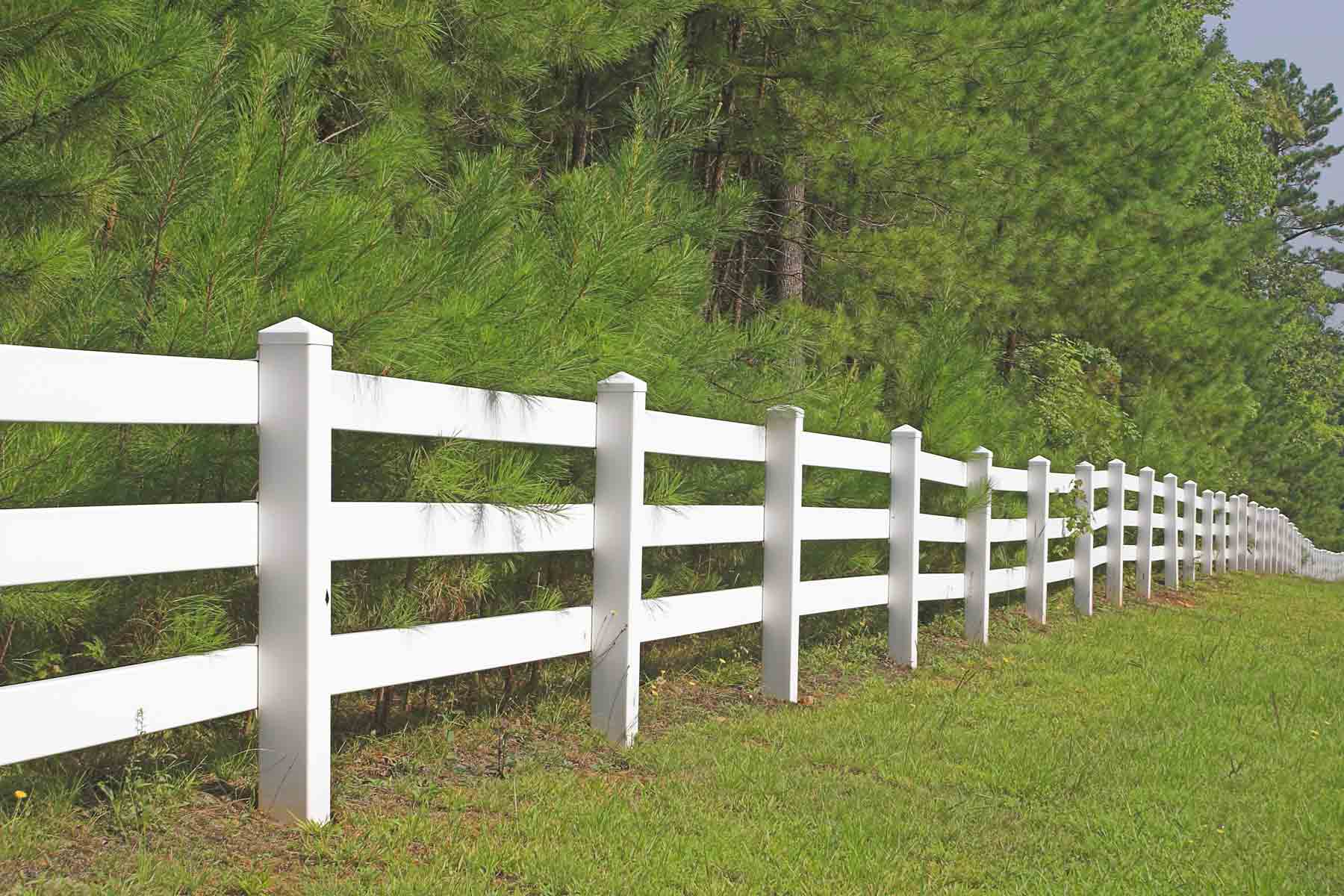PVC fencing has exploded in popularity over the last few decades, especially in suburban neighborhoods and smaller acreages. It looks clean, installs quickly, and often gets marketed as “maintenance free.” But when you start asking folks who’ve actually lived with it, the story isn’t quite so simple.
On a working ranch or horse property, fencing isn’t about looks—it’s about performance. PVC can work in some situations, but it has serious limitations that every operator, rancher, or horse owner should understand before buying miles of it.
What Is PVC Fencing?
PVC (polyvinyl chloride) fencing is made from plastic extrusions formed into rails, boards, and posts. Most systems are hollow with internal reinforcements for strength. It’s sold as a clean, low-maintenance alternative to wood, with styles that mimic traditional board fencing.
PVC caught on fast in residential markets where the priority was curb appeal with minimal upkeep. The glossy finish, clean lines, and lack of paint or stain made it attractive to homeowners. But agriculture fencing is a different world.
The Marketing vs. the Reality
PVC fencing is often advertised as:
- Maintenance free
- Weather resistant
- Long lasting
- Safer than wood
In reality, the picture looks different when you factor in livestock, extreme weather, and years of exposure.
- PVC isn’t maintenance free. Dirt, mold, and algae stick to it and require cleaning. Cracks and breaks need replacing, not repairing.
- It resists moisture, but sun and temperature swings take their toll. PVC becomes brittle in cold weather and soft in extreme heat.
- “Long lasting” depends on where you live. In mild climates, PVC may hold up a couple decades. In high UV, high wind, or cold regions, it can fail in less than 10 years.
- As for horse safety, broken PVC doesn’t splinter like wood, but it does shatter into sharp shards when hit hard enough.
Where PVC Works
PVC fencing isn’t all bad, though. It just needs the right context.
- Decorative areas: Property entrances, gardens, and residential-style boundaries where aesthetics matter more than containment.
- Light-use containment: Smaller animals like dogs or miniature livestock in low-pressure areas.
- Dry, mild climates: Regions without extreme cold, heat, or UV exposure see far fewer failures.
- Budget-driven installs: For landowners who prioritize upfront cost over longevity, PVC provides a cheaper short-term solution than steel or composite systems.
Where PVC Fencing Fails
In serious agricultural use, PVC just doesn’t work:
- Horse containment: Horses lean, kick, and push on fences. PVC rails pop out of posts under pressure, and broken rails leave sharp edges.
- Cattle fencing: The sheer weight and pressure of cattle overwhelm PVC, leading to sagging, cracking, or complete collapse.
- High UV exposure: Sunlight breaks down the plasticizers in PVC, leaving it chalky, brittle, and prone to shattering.
- Cold climates: Below-freezing temperatures turn PVC brittle enough to crack under impact.
- High wind zones: Hollow rails act like sails. Strong winds twist posts and blow panels out.
In short: PVC works for looks. It fails under pressure.
Comparing PVC to Other Fencing Materials
When deciding on fencing, it helps to put PVC side by side with other fencing materials.
| Material | Average Lifespan | Maintenance Needs | Strength & Containment | Safety for Horses | Cost Over Time | Appearance |
| PVC Fencing | 5–15 years (climate-dependent) | Cleaning, replacing broken rails | Weak under livestock pressure, brittle in cold | Breaks into sharp shards, rails pop loose | High (due to replacements every decade) | Clean, glossy look that fades and chalks |
| Wood Fencing | 10–15 years (with upkeep) | Frequent painting, staining, board replacement | Moderate strength, deteriorates quickly | Splinters and broken boards pose risks | High (maintenance + replacement cycles) | Traditional, rustic look |
| Vinyl/Composite | 15–25 years (varies by quality) | Some cleaning, occasional repairs | Better UV and impact resistance than PVC | Safer than PVC but still brittle under force | Moderate–High | Attractive, residential-style appearance |
| High-Tensile Wire | 20–30 years (when installed right) | Tension adjustments, hardware checks | Strong, flexible under pressure | Can cut if not maintained; safer with smooth wire | Low–Moderate | Minimal, utilitarian appearance |
| Steel Board | 30–50+ years | Minimal—occasional wash, no painting | High strength, engineered flexibility | Smooth, impact-absorbing, safest option | Low (cost spread across decades) | Classic board look, long-lasting color |
- Wood fencing: Looks traditional but requires constant upkeep. Lasts 10–15 years with maintenance.
- Vinyl fencing (non-PVC composites): Better formulations resist UV and impact but cost more.
- High-tensile wire: More affordable and functional for livestock but less attractive.
- Steel board fencing: Combines the look of wood with decades of durability. Safe for horses, weather resistant, and recyclable.
PVC usually sits at the bottom of the performance ladder for serious operations.
Cost vs. Longevity
PVC’s biggest selling point is upfront cost. It’s cheaper than steel, sometimes cheaper than quality wood. But when you factor in replacement cycles, repairs, and lost livestock containment, the “savings” disappear.
A fence that lasts 30–50 years (like steel board) spreads its cost across generations. A PVC fence that needs replacing in 10 years costs three times more in the long run.
Safety Concerns for Horses
For horse owners, safety always comes first. PVC’s glossy finish and rounded edges might seem horse-friendly, but real-world experience tells a different story.
Horses that test fences easily pop rails loose, creating escape risks. And kicks or impacts in cold weather can shatter PVC into sharp edges. Sagging rails invite more pressure, leading to cascading failures.
That’s why most equine experts recommend against PVC as a primary containment option for horses.
The Bottom Line on PVC Fencing
PVC fencing has its place, but that place usually isn’t on a working ranch or horse property. It can provide curb appeal in light-use areas, but as primary livestock containment, it fails more often than it succeeds.
For operators who value safety, longevity, and true low-maintenance performance, steel board fencing remains the gold standard. It delivers the traditional look many people want while eliminating the cracking, sagging, and premature failures that plague PVC.
PVC fencing might catch the eye in a catalog, but the real test is time, weather, and livestock. When the dust settles, steel outlasts plastic every time.
Looking for fencing that delivers the clean look you want with the strength your animals need? Contact Buckley Fence today to explore steel board systems built to last generations.



